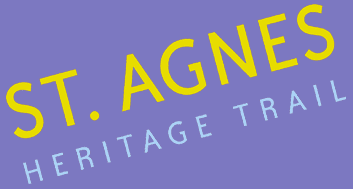
Walk 6 - Mithian
It is also suggested that the tunnel could have been a hiding place or escape route for Catholic priests or monks following the Reformation of the mid 1500s. This would seem to fit in nicely with the various stories of lost chapels, monasteries and priest holes that abound. This is a period when Cornwall and England were involved in religious persecution of both Catholics and Protestants depending on the persuasion of the particular monarch at the time. It has been rumoured that the clothing and bones of a monk was found in the tunnel but that may just be a bit of garnishing. That the tunnel exists is not in doubt; a number of people examined it when it was opened in the 1960s.
Mithian Manor
Turn left after leaving the pub along the road signposted to Perranporth and Truro. Look over the gate to your right and you will see the complex of houses that was adapted from the original buildings of Mithian Manor B. The Manor House does not give the impression that it was ever a grand building and we must assume that it was of no great importance. It did, however, own all of the land and buildings of Mithian on the north side of the river. We know that it did not exist as a manor at the time of the Domesday Book. We also know that the Wynslade family had lived there for many years at the time of the Prayer Book Rebellion in 1549. It is said to have belonged to a French Nobleman prior to that which seems perfectly reasonable considering the Norman French influence after 1066. To place its building date as between 1200AD and 1400AD would seem reasonable. As you start to descend the hill you pass over the tunnel that once connected the Miners Arms and Mithian Manor. This rather steep hill was once known as The Lane. Prior to that it was referred to as Brewery Hill, so named because the brewery horse and drays could not get up the steep hill necessitating the barrels to be hauled up by ropes and the empty ones rolled back down.
Rose-in-Vale
 As the road begins to level out at the bottom of the hill take the footpath sign posted to the left. A large Georgian
House comes in to view on the right; the beautiful hotel and grounds of Rose-in-Vale C. The Rose-in-Vale was
the winter residence of Captain John Oates who was the major owner of the Great Wheal Leisure Copper Mine
at Perranporth and many other local mines.
As the road begins to level out at the bottom of the hill take the footpath sign posted to the left. A large Georgian
House comes in to view on the right; the beautiful hotel and grounds of Rose-in-Vale C. The Rose-in-Vale was
the winter residence of Captain John Oates who was the major owner of the Great Wheal Leisure Copper Mine
at Perranporth and many other local mines.
Built circa 1770, this must have been an elegant house with its Gatekeeper's cottage at the entrance. The Tithe map of 1840 shows Capt Oates as the occupier and Sir R. R. Vyvyan as the landowner. Capt Oates probably took up residence during the very early 1800s and was living there up until the 1850s. The Nankivells and James' lived in the property before Captain Oates.
 Walk 1 - St.Agnes Village Trail
Walk 1 - St.Agnes Village Trail Walk 2 - St Agnes Beacon
Walk 2 - St Agnes Beacon Walk 3 - Porthtowan, Banns Vale, Mount Hawke and Chapel Porth
Walk 3 - Porthtowan, Banns Vale, Mount Hawke and Chapel Porth Walk 4 - Wheal Rose, The Poldice Plateway and Mawla
Walk 4 - Wheal Rose, The Poldice Plateway and Mawla Walk 5 - Mount Hawke
Walk 5 - Mount Hawke Walk 6 - Mithian
Walk 6 - Mithian Walk 7 - Wheal Coates, Chapel Porth, Wheal Lawrence Valley and Goonvrea
Walk 7 - Wheal Coates, Chapel Porth, Wheal Lawrence Valley and Goonvrea Walk 8 - Water Lane, Wheal Butson and Jericho Valley
Walk 8 - Water Lane, Wheal Butson and Jericho Valley Walk 9 - Jericho Valley and Cross Coombe
Walk 9 - Jericho Valley and Cross Coombe Walk 10 - Blackwater
Walk 10 - Blackwater
